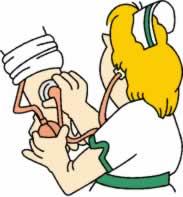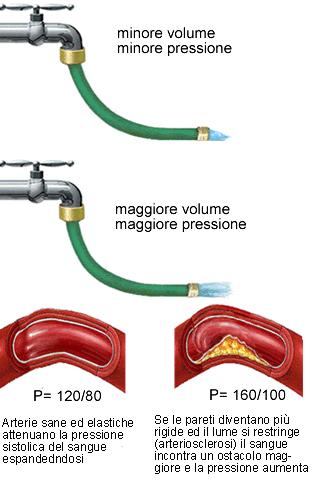Blood pressure is the force with which blood is pushed through the vessels.
It depends on the amount of blood that the heart pushes when it pumps and on the resistances that oppose its free flow
What is blood pressure
PHYSICS teaches that pressure is directly proportional to the force acting in a direction perpendicular to a surface and inversely proportional to the area of the surface to which the force is applied (P = F / S). Consequently, the smaller the surface (needle of a pin, blade of a knife, etc.) the more the pressure increases (with the same force applied).

We become aware of this physical law when, for example, we walk on fresh snow and sink. In this situation, our body exerts a force F on the ground through a support surface S given by the size of the soles. When moving on skis, the sinking is much less noticeable as the contact surface S increases.
The pressure can be expressed through different units of measurement (Pascal, Torr, Atmosphere, Bar, ata).
When it comes to blood pressure, the reference scale is the millimeter of mercury (abbreviation mmHg)
PHYSIOLOGY teaches that the heart is a very effective pump capable of lifting a ton to a height of ten meters in 24 hours. By contracting and relaxing, this precious organ sends blood to all the tissues of the body. The work done by the heart is so remarkable that in the course of its life it pumps about 190 million liters of blood which would be enough to lift an entire aircraft carrier three meters.
Each time this muscle contracts (systole) the blood is circulated with a remarkable speed (about 50 cm / second). The walls of the aorta, the main arterial vessel that exits the heart, are forcefully stretched by the passage of blood. Fortunately these walls are not rigid but have the possibility of dilating and contracting in relation to the amount of blood that passes through them. This mechanism allows you to effectively regulate blood pressure.
The maximum pressure therefore depends on the efficiency of the heart pump (amount of blood expelled with each contraction) and on the elasticity of the artery walls. Under normal conditions, the maximum or systolic blood pressure is 120 mmHg. When the lumen of the arteries narrows or the elasticity of the walls decreases, the blood has greater difficulty in flowing and the maximum pressure rises above normal values.
When the emptying of the heart ends, the filling phase begins (diastole). In this period the blood flow in the arteries decreases as well as the pressure which reaches its minimum value (diastolic or minimum pressure) just before the start of the new systole.
The minimum arterial pressure therefore depends on the resistance that the blood encounters in the peripheral tissues. The more the flow is obstructed, the slower the pressure drops. In this situation the minimum value reached before the next systole is higher than the normal value of 80mm Hg.
Arterial pressure = cardiac output x peripheral resistance.
Cardiac output is the amount of blood expelled from the left ventricle at each systole multiplied by the number of beats per minute.
Blood pressure is therefore determined by three main factors:
- the amount of blood that is released into the circulation during systole and its viscosity (hematocrit)
- the force of contraction of the heart
- the resistance offered by the vessels (arteries and veins) to the passage of blood flow;
These three elements undergo an external control mediated above all by hormonal and nervous stimuli. Our body is in fact able to autonomously regulate heart pressure according to the metabolic needs of the various organs. Due to circadian rhythms, blood pressure varies throughout the day, reaching its maximum values in the early morning and late afternoon.
Attention, the pressure rises at night. For this, according to experts, nighttime blood pressure is the most important.

So, for example, as we go up the stairs, the pressure increases both because the muscles and the respiratory system need more oxygen (increase in systolic output and heart rate) and because muscle contraction tends to occlude the vessels, increasing peripheral resistance. On the contrary, while we sleep the pressure is lowered as the metabolic demands of the various organs are lower. Even a hot bath, thanks to the dilating effect of the heat, is able to decrease blood pressure.
Blood pressure must remain within a predetermined range of values to ensure oxygen and nutrients to all tissues. This range varies from 75 to 80 mmHg for the minimum pressure and from 115 to 120 mmHg for the maximum pressure.
Below these values, the blood is not released effectively and the peripheral tissues tend to receive less oxygen and nutrients. The sense of dizziness, blurred vision and fainting felt by those suffering from low blood pressure is due to the reduced supply of oxygen to the cells of the brain. Even "healthy" people notice these effects when, for example, they suddenly get up from a lying position (orthostatic hypotension). In these cases, there is a sudden drop in pressure due to the force of gravity that draws the blood into the lower vessels, at the same time causing a temporary overflow of blood at a local level. Under normal conditions the vessels respond to this phenomenon by contracting and thus hindering the downward flow; at the same time, the increase in pressure is favored by the acceleration of the heartbeat.
When a person suffers from hypertension, the vessel walls are forced to withstand strong stresses which, when they become particularly high, can cause them to rupture. This predisposes the individual to arteriosclerosis and dangerous organ damage that generally involves the kidneys, heart, vessels, brain and in some cases even the eye. The heart, just to cite an example, is forced to contract against a high resistance and can "give way" (heart attack) due to excessive effort.
Other articles on 'Blood pressure, what it is and how it is measured'
- Hypertension and physical activity: contraindications?
- Ipertensione
- Age and Hypertension
- Hypertension: Causes and Risk Factors
- Hypertension Symptoms - Why Is High Blood Pressure Dangerous?
- Hypertension Treatment - Healing from High Blood Pressure
- Medicines against hypertension
- Hypertension and physical activity
- How is pressure measured?
Blood Pressure: The Most Popular Meters on Amazon
Keeping blood pressure under control is a good habit, since a wide range of factors affect its values and it is important to check that it is not subject to fluctuations. For several years now, i blood pressure gauges portable, which you can keep on hand and ready to use in case a measurement is required. Here are some of the most popular products that can be purchased online.
Among blood pressure monitors, it is particularly successful on Amazon OMRON X2 Basic, which offers an oscillometric method of blood pressure measurement with the support of a cuff, which allows you to check your blood pressure from the comfort of your home. Easy to use, it allows monitoring of blood pressure at home with reliable, accurate results and with the detection of irregular heartbeats. For accurate home monitoring, X2 Basic measures blood pressure by detecting blood movement in the brachial artery thanks to the 22-32cm cuff
Sanitas SBM 21 is an upper arm blood pressure monitor that classifies the measurement results with a colored scale, detects the heart rhythm and warns in the event of a possible arrhythmia. It is equipped with a large LCD display with date and time, automatic stop device. This product is particularly appreciated for its cost-effectiveness: it is intended for arm circumferences of 22 - 36 cm and has a practical carrying case supplied.
Il HOMIEE blood pressure monitor has a 5 "backlit LCD sphygmomanometer, which offers a clear display of all measured values on a large screen, including date and time display, which is particularly easy to read for the elderly. Up to 180 readings can be recorded: the cuff size is 22-42cm, suitable for different arm circumferences. Two power options: Comes with 4 AAA batteries, which can be powered via the Type-C interface, although the charging cable is not included If no operation is performed, the machine will automatically turn off after three minutes.
For further information: Better Blood Pressure Gauge: More Efficient Models


























